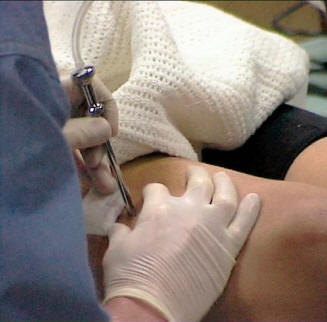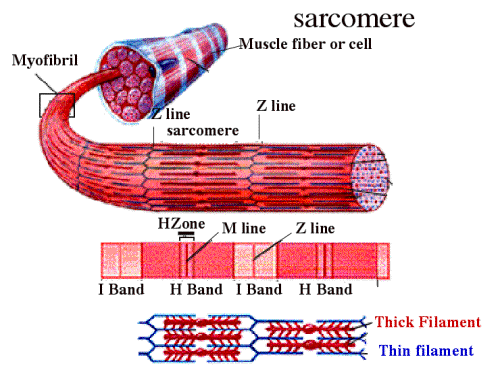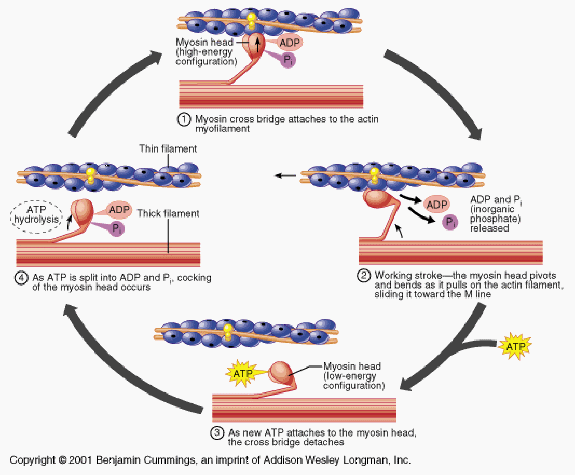
Terms
Aerobic Metabolism: The creation of ATP through the combustion of carbohydrates and fats in the presence of oxygen. Thirty-eight molecules of ATP can be produced by aerobically metabolizing one glucose molecule.
All or None Law: When a threshold level for activation is reached for a specific motor unit, all the muscle fibers in that motor unit are activated.
Anaerobic Energy Producing Systems: 1.) ATP-PC source; ATP and PC are stored within the muscle. During high intensity short burst activities ATP is broken down into ADP and Pi. When PC is broken down into creatine and Pi the resulting energy is used to recombine ADP and Pi into ATP. 2.) Anaerobic Glycolysis/Lactic Acid Energy Source. Glycogen stored within the muscle is split in half to yield two pyruvate molecules and release energy. The energy released from splitting each glucose molecule produces a net gain of two ATP. The pyruvate is then transformed into lactic acid. Anaerobic Glycolysis can produce a greater amount of energy than the ATP-PC source; however, it can’t supply the muscle with as much energy per second as the ATP-PC source and therefore is not as powerful.
Bioenergetics: The sources of energy for muscle activity.
Connective Tissue Sheaths: Epimysium surrounds the entire muscle, Perimysium surrounds groups of muscle fibers, and Endomysium surrounds individual muscle fibers.
Cortisol: In a fasted state helps to maintain blood glucose by stimulating gluconeogenesis and peripheral release of substrates, both of which are catabolic processes.
Exercise Specificity: Each physiological variable will adapt on a different time line and in a specific manner related to the exact type of exercise program performed.
Golgi Tendon Organs: Located within the tendon, the main function are to respond to tension within the tendon and, if it becomes excessive, to relieve the tension by shutting down the muscular contraction.

Growth Hormone: An anabolic hormone involved in muscle tissue growth and remodeling. The main Physiological roles of GH are:
Hyperplasia: Increase in the number of muscle fibers.
Hypertrophy: Growth in muscle fiber size.

Insulin: Has the ability to stimulate and increase protein mass.
Insulin-like Growth Factors: Small polypeptides that mediated the effects of GH. IGF is secreted by the liver.
Length-tension (force) Curve: Demonstrates that there is an optimal length at which muscle fibers generate maximal force. The total amount of force developed depends on the total number of myosin cross-bridge interaction with the active sites on the actin. At the optimal length there is the potential for maximal cross-bridge interaction and thus maximal force.
|
Fig. ME3. Length-tension relationship of a single frog semitendinosus muscle fiber (From Gordon et al., 1966). The numbers 1 through 6 on the length tension curve correspond to the numbers on the schematic diagram of thick and thin filament arrangement. In this way the relationship between thick and thin filaments can be compared to the tension at various sarcomere lengths. |
Motor Unit: is a single motor neuron and all of the corresponding muscle fibers it innervates.

Muscle Biopsy Technique: The most common method of obtaining a muscle sample in humans. A hollow stainless steel needle is used to obtain 100-400mg of muscle tissue (typically from a thigh, calf, or arm muscle. The sample is removed from the needle, processed, and then frozen. The muscle sample is then cut in to consecutive sections and placed on cover slips for histochemical assay to determine various muscle fiber types.


Muscle Spindles: Located in modified muscle fibers and therefore are arranged parallel to normal muscle fibers, muscle spindles monitor stretch or length of the muscle in which they are embedded, and initiate a contraction to reduce the stretch in the muscle.

Myosin ATPase Staining Method: A histochemical method of determining between Type I and Type II muscle fibers in a sample.

Neuromuscular Junction: The morphological structure that acts as the interface between the alpha motor neuron and the muscle fiber.

Proprioceptors: specialized sensory receptors located within the muscles and tendons continually monitoring muscle and tendon length and tension.
Sarcomeres: The basic unit of a muscle's cross-striated myofibril. Sarcomeres are composed of Actin and Myosin filaments. See Sliding Filament Theory for a picture

Size Principle: Recruitment of motor neurons, the smaller motor units – or what are called “low-threshold” motor units are – are recruited first.

Skeletal Muscle Fibers: Unique cylindrical multinucleated cells.


Sliding Filament Theory: Is a theory on how muscle contractions occur. As the sarcomere shortens, the actin filaments slide over the myosin filaments. This causes the H zone to seem to disappear as actin filaments slide into it and give it a darker appearance. The I bands become shorter as the Z lines come closer to the ends of the myosin filaments. When the sarcomere relaxes and returns to its original length, the H zone and I bands return to their original size and appearance.


Testosterone: One of the primary anabolic hormones involved in muscle tissue growth and remodeling.

Type I (slow twitch): Low-threshold motor units. Produce low rates of force over long periods of time.
Type II (fast twitch): High-threshold motor unites. Produce high rates of force over short periods of time.
![[sprinter.bmp]](http://2.bp.blogspot.com/_FQPHfAFnk70/ShW1_IJyHaI/AAAAAAAAAAs/RFNyuWMuzbI/s1600/sprinter.bmp)
Velocity and Force-Time Curve: using strength training you want the curve to shift up and to the left.

Resistance, Strength, and/or Weight Training – a type of exercise that requires the body’s musculature to produce force (move or attempt to move) against an opposing force
à Resistance and Strength Training encompass a wide range of training modalities, including plyometrics and overload running
à Weight Training typically is used to refer to only normal training using free weights or weight machines
Repetition – one complete movement of an exercise which normally consists of two phases, the concentric muscle action (lifting the resistance) and the eccentric muscle action (lowering the resistance)
Set – a group of repetitions performed consecutively without stopping
Repetition Maximum (RM) – the maximum number of repetitions per set that can be performed at a given resistance with proper lifting technique. The set is performed to momentary voluntary fatigue.
à 1RM is the heaviest resistance that can be used for one complete repetition but not for two, 10RM is the maximum for 10 repetitions but not 11 repetitions.
Power – the rate of performing work. The weight lifted x the vertical distance the weight travels / the time to complete one rep
Example: 100 lbs lifted 3 feet vertically in 1 second would have a power output of 300 ft /lb/sec (foot pounds per second)
à Power during a repetition can be increased one of two ways.
A. Lifting the weight with greater speed.
Example: 100lb x 3 ft. / 0.5 sec would have a power output of 600 ft x lb x sec.
B. Lifting more weight (at the same speed)
Example: 125lb x 3 ft. / 1 sec would have a power output of 375 ft x lb x sec
à Power is a product of Force and Velocity (P=FxV)
Strength – The maximal amount of force a muscle or muscle group can generate in a specified movement pattern
Isometric – muscle is activated and develops force but no movement occurs. Also referred to as a static contraction. The weight is either held at a constant/stationary joint angle or is too heavy to lift any higher.
Concentric – when a weight is being lifted shortening of the muscle occurs. Also referred to as a contraction or positive
Eccentric – when a weight is being lowered in a controlled manner. The muscles involved are lengthening in a controlled manner. A muscle action where lengthening occurs. Also referred to as a negative.
Voluntary Maximal Muscular Actions (RM) – the most effective way to increase strength, the last repetition in a set to momentary concentric failure/fatigue is a voluntary maximal muscular action. Referred to as overloading the muscle.
Overload – forcing the muscle to act against a resistance that is normally does not encounter
Intensity – the load, a percentage of the 1RM or any RM for the exercise.
General Weight Lifting Intensity Scale
1RM 2 3 4 5 6 7 8 9 10
100% 95 92.5 90 87.5 85 82.5 80 77.5 75
à with each additional rep, intensity decreases 2.5%
Volume – A measure of the total amount of work performed in a training session, in a week of training, or some other time period. Useful in determining the total training stress. Easiest calculation is sets x reps.
Periodization – periodic manipulation in training volume and/or training intensity. Usually with the goal of peaking your sport specific qualities for your season or a key competition
– progressive resistance exercise, continually increasing the stress placed on the muscles as it becomes capable of producing greater force or has more endurance.Progressive Overload
à if training stimulus is not increased as the muscles become stronger, no further gains in strength will occur
Increased resistance (amount of weight used)
Increased volume (number of sets and/or reps)
Increased training velocity (power)
Decrease training velocity (time under tension)
Increased Strength
Increased Muscle Size
Improved Sports Performance
Increased Lean Muscle Mass and Decreased Body Fat
Psychological (improved self image/self-esteem)
à Resistance training can improve motor performance (sprinting, jumping, throwing, etc.). These improvements in basic motor skills can lead to better performance in various games and sports. The amount of carry over from a resistance training program to a specific sports performance depends on the transfer specificity or transfer carry-over between the training program and the sports skills.
Example: Hang Cleans vs. Leg Ext. and Leg Curl
à In general, multi-joint exercises have a greater transfer specificity than single joint exercises
increase circulation
increase heart rate
increase core temperature
increase mobility/lubrication around joints
increase elasticity of muscle connective tissue
prepare mentally for workout
increase neurological stimulation
Question – Is stretching necessary before a strength training workout?
à Static stretching is not necessary because it may be counter-productive to lifting.
à Dynamic stretching is recommended mainly through warm up sets of the actual lifts. Some brief dynamic movements won’t hurt.
** refer to the two assigned articles on warm-up and dynamic flexibility.
Question – Is stretching necessary after a strength training workout?
à Flexibility is optimally developed when a muscle is stretched in a warm,
relaxed state. After being exercised, muscles are very warm and are in a relaxed state due to fatigue
à Stretching after weight lifting is an ideal time to develop flexibility and may aid in the removal of lactic acid and aid in recovery
According to Greek mythology, Milo of Croton was the first person to apply the theory of progressive overload training (550BC). He was an Olympic wrestler, who in his teens, decided to become the strongest man in the world. He trained by lifting and carrying a baby bull every day and as the calf grew and became heavier, Milo became stronger. Finally, when the calf had developed into a full-grown bull, Milo, thanks to a long-term progression, was able to lift the huge beast. Consequently he became the strongest man on earth and he eventually ate the bull.
